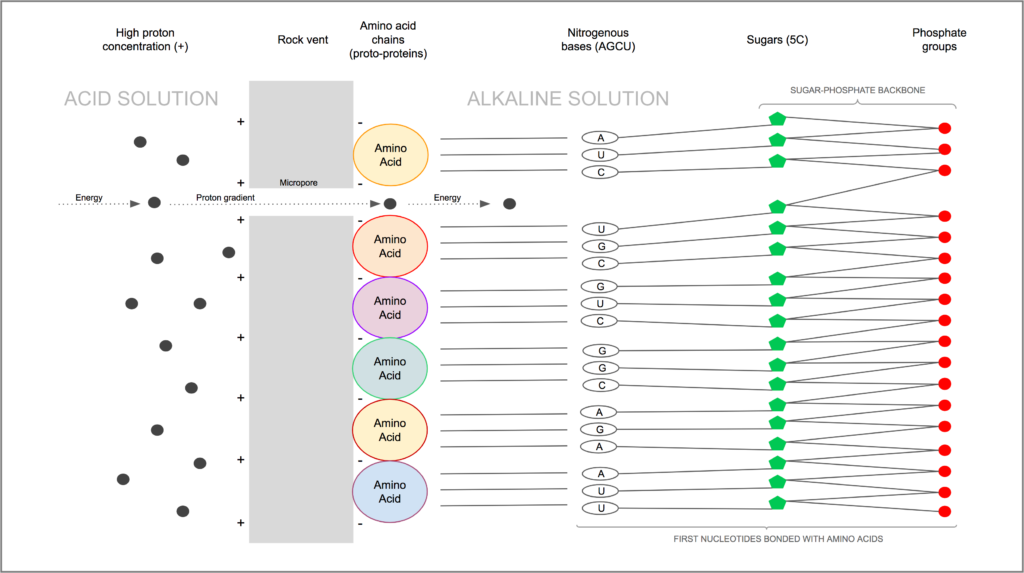Given the advanced state of life processes we observe today, it is difficult to figure out the evolutionary cause and effect events that occurred, from regular chemical reactions to life forms, during the origin of life.
In this article, I propose a sequence of events that may have led to the first replicators, likely in the form of ribonucleic acid (RNA), but in the reverse of what is observed today.
Today, cells produce proteins out of RNA code. However, in this hypothesis, the first RNA is produced from amino acid chains, or what I call “proto-proteins”, first. Then, some of those RNA codes may have given rise to more peptide chains, and so on.
The other concept I describe is that the original porous rocks of the alkaline vents, with the natural proton gradients, were not the primordial cell membranes by themselves. They were just a sort of platform for amino acid chains to layer on top, in the form of films or sheets. These eventually evolved to become cell membranes proper.
Possible Sequence of Events
1. Permanent proton gradients, in alkaline hydrothermal vents, and amino acids existed naturally [1] [2] in ancient oceans.
2. Some amino acids randomly bonded and formed chains (the peptide bonds perhaps catalyzed by the energy of flowing ions) around rock membrane micropores (holes) where the protons passed through from the (+) side to the (-) side*.
3. The great overwhelming majority of these peptide chain formations (proto-proteins) around proton pathways had no consequence or function whatsoever.
4. Adenine, guanine, cytosine, thymine, and uracil molecules (nitrogenous bases A, G, C, T, and U [3]) formed naturally, or perhaps by reactions in some of the formations on step 2, and attached to many peptide chains forming layers on top of these chains.
5. As AGCT and U serve as the negative of some amino acids, those amino acids perhaps attached on top of these layers forming a sequence of multiple layers of positive and negative peptide and AGCTU films (2 dimensional sheets).
6. Some very rare peptide chain formations on step 2, when protons passed thru, also formed sugar-phosphates [4], or ADP and/or ATP [5] (sugar + phosphates groups + nitrogenous bases).
7. These drifting sugar-phosphate molecules attached to AGCT and U that were randomly layered on top of peptide chains forming the first nucleic acid molecules [6] (these were 1 dimensional, as the structure couldn’t support 2 dimensions, so they served as the linear backbones for AGCT – DNA – and AGCU – RNA -).
8. Perhaps, many of the nucleic acids (some DNA and others RNA) just floated with no purpose or direction in the solution. Others may have served as the code to form other identical peptide chains, hence “replicators”, that drifted or attached to ion pathways (the alkaline hydrothermal vents in porous rocks) to repeat the cycle.
9. After a long time and many iterations, thus mutations, more complex structures emerged (softer and harder organic membranes, enclosure into cells, electron transport chains along proteins, more complex and longer complementary proteins, etc.).
* The (+) side eventually became the external part of living cells, the (-) side the internal part.
Key Points of the Hypothesis

The first key point of the above sequence is that proteins came first and RNA/DNA second. Maybe the above are not the exact steps, and perhaps not technically precise nor accurate (it’s like a rough pseudo program or algorithm), but the idea is that amino acids formed some chains first and then those proto-proteins may have served as the template for the first RNA or DNA molecules (RNA most likely, in the beginning, as they are simpler).
I believe the current intuition is that RNA came as the first “replicator” [7], as that is the observation in all life forms, but it was the other way around in this hypothesis.
The other key point is that the rock membranes in ancient vents were not the actual membranes, but the layers of amino acids that formed as films, or sheets, on top (many of which were useless) eventually formed some kind of ancient membrane.
The natural (+) to (-) proton gradient was key, of course, and that was due to the alkaline solution flowing out of the ancient vents vis a vis the more acid sea water.
Summary
1. Proton gradient & amino acids existed naturally.
2. Peptide chains formed around rock openings, or pores, where energetic protons flowed through the proton gradient.
3. Peptide chains and AGCTU bases, the latter also formed perhaps naturally or on step 2, created complementary positive and negative layered films, which would eventually evolve into enclosed cell membranes, but no linear nucleic acids yet.
4. Sugar-phosphates or ADP/ATP formed naturally or on step 2.
5. RNA/DNA formed using these sugar-phosphate molecules as ‘backbones’, but these were unidimensional linear chains rather than bidimensional films or sheets.
6. RNA/DNA served as the negative to form more peptide chains, which perhaps attached to the vent openings, perpetuating the cycle, and increasing their populations.
References
[1] Our great…grandmother was a proton-powered rock – by Nick Szabo: http://unenumerated.blogspot.com/2009/10/our-greatgrandmother-was-proton-powered.html
[2] Miller–Urey experiment – by Wikipedia: https://en.wikipedia.org/wiki/Miller%E2%80%93Urey_experiment
[3] Nitrogenous Base overview – by Science Direct: https://www.sciencedirect.com/topics/biochemistry-genetics-and-molecular-biology/nitrogenous-base
[4] Sugar Phosphates overview – by Science Direct: https://www.sciencedirect.com/topics/agricultural-and-biological-sciences/sugar-phosphates
[5] ADP & ATP – by Britannica: https://www.britannica.com/science/adenosine-triphosphate
[6] Nucleic Acids – by Genome.gov: https://www.genome.gov/genetics-glossary/Nucleic-Acid
[7] The Replicators, Chapter 2, The Selfish Gene (book) – by Richard Dawkins: https://www.litcharts.com/lit/the-selfish-gene/chapter-2-the-replicators
Code Is Law